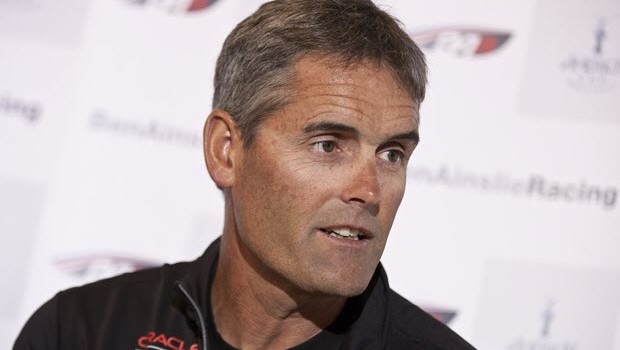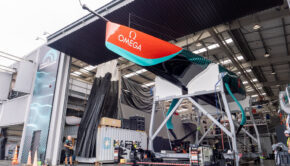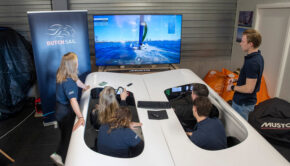America’s Cup: Russell Coutts silences the crickets
Published on May 6th, 2014
Since the final race of the 34th America’s Cup on September 25, 2013, it has been quiet. Cricket quiet. After the momentum of the last match, the train came to a halt, and has yet to leave the station.
Promises of a Protocol for the 35th America’s Cup were for March, and then April. Iain Murray, Team Australia CEO and America’s Cup Challenger of Record, expects it to be released by mid May. He said it’s been a bit of a tussle, with both sides making sacrifices, but all that remains is to dust the details.
The Protocol – offering the rules for the next event – is an agreement between the Challenger of Record and the Defense. We tracked down Murray’s counterpart, Russell Coutts, CEO of Oracle Team USA, for an update.
Russell was in China, though choosing not to share any details for his visit. But he was working, and the extent of his travel for this next America’s Cup seems to have few limits. After battling a 21 hour time difference to connect, here are a few bullet points:
* The event is shifting from a design competition to a sailor competition.
* The commercialization of the event drives decisions.
* The AC World Series will count toward challenger selection.
* The challenger series may be held at two separate venues.
In Part 1, Russell comments on the ideology of the next America’s Cup…
A lot of decisions about the competition are dictated by the commercial side. When you talk to the broadcasters, it is really tough for them to accommodate a long schedule. Plus, so much of the early racing lacks sufficient significance. This was exemplified in the 34th America’s Cup, which began in early July and extended to late September. For the commercial side, the long schedule we are used to doesn’t work well.
When you talk to the broadcasters, the racing needs to be more meaningful. With the early rounds meaning little, it is hard to sell what essentially amounts to practice races. It is hard to sell exhibition. So we need to make it such that results matter, and when teams don’t perform, they get eliminated. That’s sport.
While we want more teams to participate, what we really need are serious, competitive teams. It is typical of the America’s Cup in the past where a bunch of teams have entered, and then along the way they might drop out, and if they make it to the challenger races, they aren’t sufficiently funded and prove to be uncompetitive. This situation doesn’t add value to the event. Some people will say that more teams are better for the event, but others will argue that the less prepared teams damage the event.
What’s important is that the teams that enter the America’s Cup are teams that are prepared to complete the entire schedule. This is particularly important for event sponsors, in which the terms of the contract are based on a certain size event. When there are teams that drop out, like we had in the 34th America’s Cup, it becomes a problem.
So we put in terms for this Protocol that are quite difficult for entry. There will be significant requirements to ensure the teams are seriously prepared to participate.
This was our intention for the 34th America’s Cup, but we backed away to be more accommodating, and then later regretted it. We should have stuck to our guns from the outset, and odds are, we would have known early on that we’d only have four challengers. Which is what we had. Knowing early on would have made all the planning so much easier.
We learned a lot last time. Fundamentally, the America’s Cup Finals last time turned out to be pretty good, and showcased how some of the concepts we had pursued had some merit. Certainly the broadcast was pretty good. So we are developing from there, learning from those lessons, and seeing how we can better serve prospective sponsors and broadcasters. This really must be a partnership with these outside entities and the competition.
Some sports are powerful enough to dictate the terms, but we are not in that position. We have to approach it differently, and see how we can organize the competition to suit all parties. Certainly we don’t want to jeopardize the competitive aspects of the event; we never would do that. But we also want to be sensible about the conditions that affect the key sponsors and broadcasters.
In Part 2, Russell shares some of the changes for this next edition…
Will the AC World Series continue?
Unfortunately the America’s Cup is not like World Cup soccer that is held every four years, yet remains attractive to sponsors and broadcasters. The AC World Series does provide this necessary activity, a regular platform for sponsors to activate off of. It also provides a showcase for the sailors, to heighten their recognition. These are both key components that can’t be achieved if the America’s Cup occurs only every four years. Maybe someday it’ll be possible, but not today.
We must remember that we also needed the AC World Series last time to help develop the broadcast technology. We needed to have something to sell.
But since the AC World Series didn’t count for anything, not all the teams took it too seriously. Plus it included teams that we allowed to enter the America’s Cup, but were later determined to be underfunded to compete in the challenger series. There were some good racing, but when people would ask what the teams were really racing for, there was no good answer to the question.
So a change for the 35th America’s Cup is that the AC World Series in AC45s will count toward qualification. This will put some meaning to the series, and the series will provide a relatively low-cost platform for the teams to get their footing before they launch their AC 62 in late 2016 or early 2017.
The venues under review are asked to accommodate only four challengers and one defender. Explain.
There is limited wharf space in the US, which limits the number of teams that can be properly hosted. So the concept is to have the challenger elimination series in AC62s begin somewhere else in the world, and then have the top four challengers complete the series at the final venue in the US. (Note: It is assumed that two venues are needed only with more than four challengers.)
Iain indicated the America’s Cup will be between June and September in 2017.
In the past, teams have gotten together and established the schedule, which was a mistake. A more sensible way is to work with the broadcaster and determine the optimum schedule for the event. What time of year, what days of the week, what hour of the day all contribute. These factors certainly must also be in synch with the venue selection, but proper scheduling will maximize the audience. This will be difficult to finalize until we commit to a broadcaster and see where we can best fit in their schedule, and amid the sporting landscape.
In the final segment, Russell discusses the venue selection…
As good a stadium as San Francisco was for the 34th America’s Cup, it was not possible to see the entire course well from land without the assistance of a broadcast monitor. Plus it proved hard for the event to monetize the spectating. Is convenient course location still a priority?
The convenient race venue is very important for corporate hospitality, as you don’t want to take people long distances to the open water. While it may not always be easy to see the entire race course, you still do want to see the boats up close. People tend to get excited when they get a glimpse of the boats.
The racing last summer was not unlike most sport events, which all tend to be easier to see on the broadcast. However, it is hard to replace that live spectating atmosphere. Plus I find that looking at the boats live as opposed to on the broadcast was different. It provided a different view. So we still feel that live spectating is an important factor.
Certainly with regard to sponsor interests, which is an important component, not everyone wants to go on the water to watch the race. And not everyone needs to see the whole race. Some of the guests went on the water for only a portion of the race and then came back in. These factors become much more challenging when the course is held a few miles from the harbor base.
Some of the venues we are considering will lend themselves better to land spectating than other, and that is one of the factors we are weighing. There is no one perfect venue. For example, at the event village in San Francisco, you couldn’t see most of the course, so you relied on the monitors. But there were many advantages with it as well.
Among the venues being considered is the inner bay of San Diego. Doesn’t this confined space change the racing style of the America’s Cup?
In the traditional sailing sector, there’s a sense that racing must be in the open water with steady winds, and have a drag race upwind to a side. They believe the race must be long, maybe a couple hours. Odds are the best sailors will come out on top, but I could also argue that long courses are more random, as it is harder to see the conditions a couple miles up the leg. So it is easier to be wrong on a long course than on a shorter course, where the water and wind conditions are easier to read. So in some ways, I think, that shorter course racing takes the uncertainty out of it.
But I tend to believe the best sailors win regardless of the conditions and course size. The best sailors can read the wind on the water and interpret the conditions, and more often than not, get it right. Maybe the club sailor looks at confined venues as fluky, but the good sailors are able to operate in these conditions and allow their abilities to shine through. We saw this in the last Cup. We saw errors, we saw strengths. There were good decisions and bad decisions on display, and that’s what sailboat racing is all about.
The RC44 Cup San Diego was there in March 2011 and the AC World Series was there in November 2011, and while they both proved to be good events, they were held during the wrong time of year for ideal San Diego conditions. We knew that, and in some sense we got lucky. But the summer season could work quite well. What we learned from San Francisco is that you don’t need open water for the racing to be tactical. In many ways, when you put the racing in a confined space, it creates intriguing tactical elements.
During the summer in San Diego Bay, we should expect to get 10-12 knots, and in these boats that’s good breeze. They’re probably going 35 knots downwind. When you lay out the boundaries for the typical wind direction, San Diego Bay fits the course really well. The reaching start, near where the event village could be, sends the fleet within view of the turning mark, and then the race heads toward the iconic Coronado Bridge. Plus the Navy has been responsive to shifting some of their boundaries on the North Island side of the Bay, so it could prove well.
San Diego clicks a lot of boxes. The boats might be maneuvering every minute and a half. It would be a highly technical course in the AC 62 and would lay out quite well for spectators and sponsor fulfillment.
Report by Craig Leweck, Scuttlebutt Sailing News









 We’ll keep your information safe.
We’ll keep your information safe.